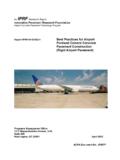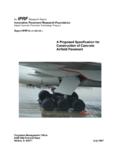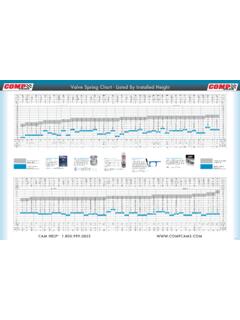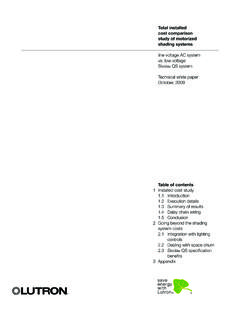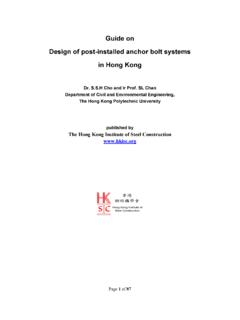Transcription of Evaluation of Dowel Bars Installed Using Plastic …
1 An IPRF Research Report Innovative Pavement Research Foundation Airport Concrete Pavement Technology Program Report Evaluation of Dowel bars Installed Using Plastic Sleeves Programs Management Office September 2004 1010 Massachusetts Avenue, Suite 200 Washington, DC 20001 This report was prepared for the Innovative Pavement Research Foundation (IPRF) under the Airport Concrete Pavement Technology Program.
2 Funding is provided by the Federal Aviation Administration under Cooperative Agreement Number 01-G-002-01. Dr. Satish Agrawal is the Manager of the FAA Airport Technology R&D Branch and the Technical Manager of the Cooperative Agreement. Mr. James L. Lafrenz is the IPRF Cooperative Programs Manager. The contents of this report reflect the views of the authors, who are responsible for the facts and the accuracy of the data presented within. The contents do not necessarily reflect the official views and policies of the Federal Aviation Administration.
3 This report does not constitute a standard, specification, or regulation. An IPRF Research Report Innovative Pavement Research Foundation Airport Concrete Pavement Technology Program Report Evaluation of Dowel bars Installed Using Plastic Sleeves Principal Investigator H. Thomas Yu, Applied Research Associates, Inc. ERES Consultants Division 505 W. University Ave. Champaign, IL 61820 Programs Management Office September 2004 1010 Massachusetts Avenue, Suite 200 Washington, DC 20001 iv vTABLE OF CONTENTS 2.
4 3. Dowel BAR 4. Evaluation OF PCC 5. Evaluation OF SURFACE 6. 7. LIST OF FIGURES Figure 1. (a) A Plastic sleeves being inserted into Plastic concrete; (b) Plastic sleeves after the insertion; (c) Stripping the Plastic insert; (d) A hole left behind after striping the Plastic sleeve ..1 Figure 2. Test section for Plastic sleeve at Hopkins International Airport in Cleveland, OH ..3 Figure 3. MIT Scan-2, a magnetic imaging device for measuring Dowel bar alignment ..3 Figure 4. Example output of MIT Scan-2 showing the orientation of the detected bars .
5 4 Figure 5. Comparison of vertical misalignment of Dowel bars Installed Using the conventional method (drilled) and Plastic sleeves ..6 Figure 6. Uniform vs. random misalignment of Dowel bars ..6 Figure 7. Comparison of horizontal misalignment of Dowel bars Installed Using the conventional method (drilled) and Plastic sleeves ..7 Figure 8. Plastic sleeve inserter attached to the paver ..7 Figure 9. Dowel holes created Using Plastic sleeves: (a) result where the horizontal hydraulic jack snagged; (b) result where the equipment functioned Figure 10.
6 Comparison of horizontal misalignment, excluding the sleeves that experienced equipment problems ..9 Figure 11. Comparison of resultant alignment ..9 Figure 12. Illustration of coring location ..10 Figure 13a. Core 1 from the Plastic sleeve section ..10 Figure 13b. Core 2 from the Plastic sleeve section ..11 Figure 13c. Core 3 from the Plastic sleeve section ..11 Figure 14a. Core 1 from the control section ..12 Figure 14b. Core 2 from the control section ..12 Figure 14c. Core 3 from the control section ..12 Figure 15. Quality of Dowel support at the joint face: (a) typical spalling at the joint face of drilled holes; (b) smooth, formed hole produced by Plastic sleeve.
7 13 Figure 16. Measurement of elevation difference between points away from the dowels and over dowels Using a Dipstick ..14 Figure 17. Identification of Dowel location Using MIT Scan-2 ..15 Figure 18. Elevation difference between Lines A and B shown in figure 16 ..15 Figure 19. Variation of elevation differences between Lines A and B shown in figure vi 11. INTRODUCTION The conventional procedure for inserting Dowel bars at longitudinal construction joints involves drilling holes after the concrete has gained sufficient strength. A new, innovative Dowel bar installation procedure has the potential to greatly facilitate concrete pavement construction by eliminating the drilling step.
8 The procedure involves inserting Plastic sleeves into Plastic concrete (Figure 1). The Plastic sleeves are later stripped (Figure 1c), and the dowels are Installed in the holes left after the removal of the Plastic sleeves. Plastic sleeves can be stripped without causing damage to concrete at a lower strength than for drilling. This early access to pavements can be important in time-critical projects. (a) (b) (c) (d) Figure 1. (a) A Plastic sleeve being inserted into Plastic concrete; (b) Plastic sleeves after the insertion; (c) Stripping the Plastic insert; (d) A hole left behind after striping the Plastic sleeve.
9 2To demonstrate that the new technique for Dowel bar installation is free of deleterious effects, the technique must produce Dowel bar alignments that exceed or are comparable to the bars Installed Using conventional methods without causing other problems. Because the new technique involves inserting the sleeves into Plastic concrete, the following factors are also of concern: Consolidation of concrete around the Plastic sleeves. Bumps on the pavement surface (causing roughness) due to the concrete being displaced as the sleeves are inserted into Plastic concrete.
10 The objective of this study is to evaluate the viability of the new technique. This was accomplished by evaluating the factors that determine the engineering characteristics of the dowels after the installation. The factors evaluated include the following: Dowel bar alignment. Consolidation of concrete around the Plastic sleeves. The impact of the insertion techniques on pavement surface profile. 2. APPROACH The feasibility of the new construction technique was evaluated by field testing. The testing was conducted at Hopkins International Airport in Cleveland, Ohio, with the cooperation of the city of Cleveland and Anthony Allega Cement Contractors, Inc.
